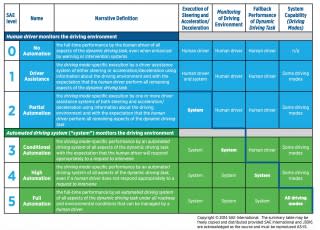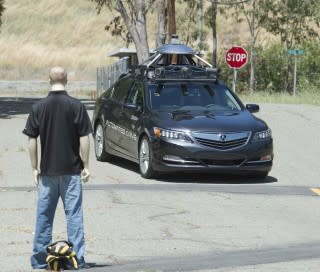Self-driving cars: a primer
Self-driving cars are a hot topic these days. They are part of an uncertain future, but automakers already have signaled they are constantly moving to a day when at least some of us won't drive at all.
Along the way, automakers will offer various levels of self-driving capability. Just what are those levels and how are they defined? We are here to help.
While the levels of self-driving sophistication can vary significantly from one brand to another, the defined bounds of those levels are relatively set.
CHECK OUT: Auto companies look for federal exemptions for self-driving tests
In 2014, the Society of Automotive Engineers adopted a common taxonomy for self-driving cars that defined six levels—from Level 0 to Level 5—of automated driving. The boundaries are pretty obvious. Level 0 is no assistance and Level 5 is fully autonomous.
It's important to note that automakers have described some self-driving functions as being "fully autonomous" or "Level 5" (notably Tesla), but fully self-driving cars are outlawed on virtually every road in the U.S., and the terms and levels aren't interchangeable. Most self-driving functions on cars hover around Level 2 or Level 3, although automakers have said they will make available Level 4 cars around 2020. Fully autonomous, Level 5 cars are decade away at least—and it's entirely possible that they won't be initially available to consumers when they arrive, if ever.
MORE: Otto's self-driving Budweiser beer-truck completes 120-mile run
So what do these levels mean?
Level 0: No self-driving functions at all. Drivers are responsible for controlling steering, throttle, and braking. They're also responsible for monitoring everything around the car. Even with blind-spot monitors and forward collision warning, a vast majority of cars on the road today would fall into this category.

Level 1: Some driver assistance. In cars equipped with Level 1 automation, the car can take control of the steering or the throttle/brake in certain situations, but relies on the driver to immediately take over if those systems fail. Many newer cars are equipped with adaptive cruise control that can slow the car to a stop, which would fall into this category. Same goes for automatic emergency braking. Some cars are equipped with active lane control (also known as lane departure prevention) systems that could allow for a limited period of hands-off driving, although those systems aren't as prevalent as adaptive cruise control.
Level 2: More driver assistance. Level 2 automation differs from Level 1 automation in how many systems are used to assist drivers, but the two levels are identical in requiring drivers to immediately take over if those systems fail or stop operating. Some luxury automakers such as BMW, Mercedes-Benz, and Volvo offer systems that will take control of the throttle/brake and steering for a limited time, but require driver interaction or those systems stop, usually with several warnings to the driver. (What happens when they shut off is important in distinguishing between Level 2 automation and higher levels.) Level 2 automation also doesn't include specific tasks such as highway merging or stop-and-go traffic.

Level 3: Conditional automation. Many automakers have said that they'll skip Level 3 automation because it may be dangerous to immediately hand all driving functions back to a human that isn't required to pay attention to the road. Level 3 automation can handle all driving situations and constantly monitors the road, unlike Level 2 cars, but still requires human intervention if those systems fail. Limited testing has shown that these systems may not be safer than no automation at all, but most experts stop short of saying Level 3 cars should be prohibited.
Level 4: Nearly self-driving. Most automakers are targeting Level 4 automation for several reasons. First, it's likely to be cheaper because Level 4 self-driving cars may not require driver controls such as a steering wheel, gas or brake pedals—building a car with redundant controls for both the driver and autonomous systems would be costly and complicated. Second, Level 4 differs from Level 3 primarily because it doesn't require human intervention if self-driving systems fail. Mercedes-Benz has already implemented a system that will slow its cars to a stop from its self-driving mode if human interaction isn't detected. Volvo has said it will build a Level 4 XC90 with redundant driver controls in 2021 because, it says, customers would prefer to have the option to drive themselves. However, other automakers seem reluctant to follow that line of thinking. Ford and others have said they'll have Level 4 cars on the road around 2020 although it's unclear if those will be available to the public or confined to ride-sharing systems.
Level 5: Fully self-driving. This may seem like a logical small step from Level 4, but for most automakers, Level 5 autonomy is a giant leap for self-driving cars. Level 5 cars would be self-driving, all the time, everywhere. Considering most of the nation's roadways aren't pencil-straight interstates on a sunny day, the final SAE level would require extensive testing for sensors that can't yet read road lines in bad weather, low light, on dirt roads, or countless other variable circumstances. Although having a steering wheel and pedals wouldn't preclude a car from being Level 5, to achieve the designation those controls would be useless: Level 5 cars aren't driven by humans in any circumstance.

 Yahoo Autos
Yahoo Autos 